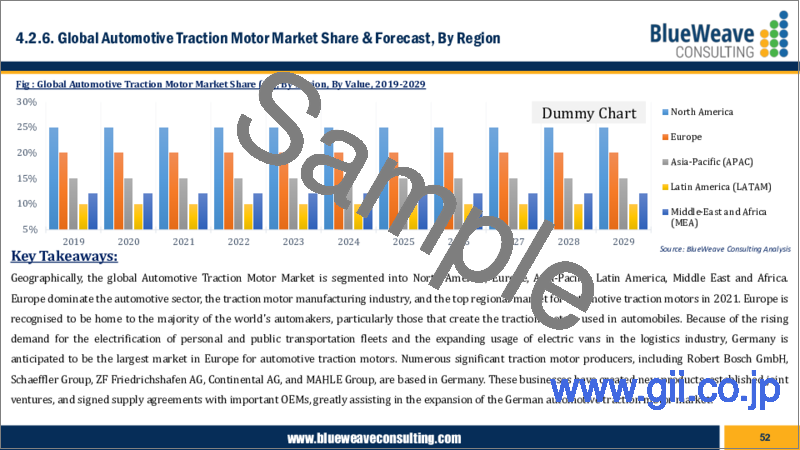|
|
市場調査レポート
商品コード
1217660
自動車用トラクションモーターの世界市場:市場規模、市場シェア、動向分析、機会、予測:車両別、タイプ別、EV別、モーター別、出力別、地域別(2019年~2029年)Automotive Traction Motor Market - Global Size, Share, Trend Analysis, Opportunity and Forecast Report, 2019-2029, Segmented By Vehicle ; By Type ; By EV ; By Motor ; By Power Output ; By Region |
||||||
| 自動車用トラクションモーターの世界市場:市場規模、市場シェア、動向分析、機会、予測:車両別、タイプ別、EV別、モーター別、出力別、地域別(2019年~2029年) |
|
出版日: 2023年02月03日
発行: Blueweave Consulting
ページ情報: 英文 200 Pages
納期: 2~3営業日
|
- 全表示
- 概要
- 目次
世界の自動車用トラクションモーターの市場規模は、2022年の68億米ドルから2029年には284億米ドルに達し、2023年から2029年までの予測期間(2022年~2028年)中に22.85%のCAGRで成長すると予測されています。電気自動車の利点に関する普及と認知度の向上、高性能および中級車/モーターの製造能力の上昇は、市場の成長を促進しています。
当レポートでは、世界の自動車用トラクションモーター市場について調査しており、市場概要、市場分析、企業プロファイルなど、包括的な情報を提供しています。
目次
第1章 調査の枠組み
第2章 エグゼクティブサマリー
第3章 世界の自動車用トラクションモーター市場の洞察
- 業界バリューチェーン分析
- DROC分析
- 促進要因
- 電気自動車の需要の高まり
- 低メンテナンス
- 抑制要因
- サポートインフラストラクチャの可用性の制限
- 機会
- 化石燃料価格の変動
- 高性能モーターの製造の増加
- 課題
- EV補助金の削減
- 技術の進歩/最近の開発
- 規制の枠組み
- ポーターのファイブフォース分析
- 供給企業の交渉力
- 買い手の交渉力
- 新規参入業者の脅威
- 代替品の脅威
- 競争の激しさ
第4章 世界の自動車用トラクションモーター市場概要
- 市場規模と予測(2019年~2029年)
- 金額別(100万米ドル)
- 市場シェアと予測
- 車両別
- 乗用車
- トラック
- バス
- ピックアップトラック
- バン
- タイプ別
- 交流
- 直流
- EV別
- BEV
- HEV
- PHEV
- モーター別
- PMSM
- 交流誘導
- 出力別
- 200kW未満
- 200~400kW
- 400kW以上
- 地域別
- 北米
- 欧州
- アジア太平洋
- ラテンアメリカ
- 中東およびアフリカ
- 車両別
第5章 北米の自動車用トラクションモーター市場
第6章 欧州の自動車用トラクションモーター市場
第7章 アジア太平洋の自動車用トラクションモーター市場
第8章 ラテンアメリカの自動車用トラクションモーター市場
第9章 中東およびアフリカの自動車用トラクションモーター市場
第10章 競合情勢
- 主要企業とその製品のリスト
- 世界の自動車用トラクションモーター企業の市場シェア分析(2022年)
- 競合ベンチマーキング:操作パラメータ別
- 主要な戦略的展開(合併、買収、パートナーシップなど)
第11章 世界の自動車用トラクションモーター市場に対するCOVID-19の影響
第12章 企業プロファイル(企業概要、財務マトリックス、競合情勢、主要な人材、主要な競合、連絡先、戦略的展望、SWOT分析)
- Aisin
- ABB Ltd
- Alstom S.A.
- American Traction Systems
- Ansaldo Signalling
- Bombardier Inc.
- Borgwarner Inc.
- Caterpillar Inc.
- CG Power and Industrial Solutions Ltd.
- Delphi Automotive Llp
- General Electric Co.
- Hitachi Ltd.
- Hyundai Rotem Company
- Kawasaki Heavy Industries Ltd.
- Magna International
- Mitsubishi Electric Corporation
- Nidec Corporation
- Prodrive Technologies
- Robert Bosch Gmbh
- その他
第13章 主要な戦略的推奨事項
第14章 調査手法
Global Automotive Traction Motor Market Size Booming 4X to Reach USD 28.4 Billion by 2029
Global automotive traction motor market is flourishing because of favorable government policies, surging demand of electric vehicles, and minimal maintenance.
BlueWeave Consulting, a leading strategic consulting and market research firm, in its recent study, estimated global automotive traction motor market size at USD 6.8 billion in 2022. During the forecast period between 2023 and 2029, BlueWeave expects global automotive traction motor market size to grow at a robust CAGR of 22.85% reaching a value of USD 28.4 billion by 2029. Major growth factors of global automotive traction motor market include increasing adoption and awareness about the benefits of electric vehicles, rising manufacturing capacity for high-performance and mid-ranged vehicles/motors, and growing government supportive policies to launch battery and electric-powered cars in developing and developed countries. Technology advancements in electric vehicles have a direct positive impact on the market for traction motors. The automobile traction motor is replacing traditional steam and diesel engines because of its high performance, modest maintenance, better reliability, and uncomplicated design, which is predicted to boost market expansion. Also, the availability of electronic brakes has lowered the cost of brake shoes, rails, and tire types, resulting in less wear and strain on the vehicles. Likewise, rising demand for the product in electric trains, trolleybuses, tramcars, and electric vehicles is expected to fuel the expansion of global automotive traction motor market. However, limited availability of supporting infrastructure is anticipated to restrain the overall market expansion.
Global Automotive Traction Motor Market - Overview:
A traction motor is a type of electric motor that uses electricity to turn the wheels of a vehicle. Automotive traction motors convert electrical energy to mechanical energy and are used to propel metros, railroads, trams, and other purposes. They are widely used in industries such as chemical and petrochemical, oil and gas, energy and power, automotive, food and drinks, and healthcare. Because automobile traction motors consume less power than traditional engines, industries are increasingly shifting away from traditional engines. The automotive traction motor market is expected to grow due to the electric motor's excellent performance, simple design, better reliability, and low maintenance. In addition, increased production of high-performance motors around the world is propelling the market forward.
Impact of COVID-19 on Global Automotive Traction Motor Market
The COVID-19 pandemic severely affected the automotive sector. Due to the worldwide lockdown, most production facilities and sites were closed. Furthermore, the raw material supply chain was severely disrupted due to a labor shortage. However, the automotive traction motor market is predicted to increase rapidly during the forecast period due to rising demand for EV and battery-powered vehicles.
Global Automotive Traction Motor Market - By Vehicle:
By vehicle, global automotive traction motor market is segmented into Passenger Cars, Trucks, Buses, Pickup Trucks, and Vans. The buses segment held the highest market share in 2022 due to rising demand for emission-free public transportation. The growing demand for electric buses promotes the demand for automotive traction motors. Increased need for greater torque and power supply in motors, which are required for quick start, powerful acceleration, and high climbing angle in cars and buses, is predicted to drive market expansion during the forecast period.
Competitive Landscape:
Major players operating in global automotive traction motor market include Aisin, ABB Ltd, Alstom S.A., American Traction Systems, Ansaldo Signalling, Bombardier Inc., Borgwarner Inc., Caterpillar Inc., CG Power and Industrial Solutions Ltd., Delphi Automotive LLP, General Electric Co., Hitachi Ltd., Hyundai Rotem Company, Kawasaki Heavy Industries Ltd., Magna International, Mitsubishi Electric Corporation, Nidec Corporation, Prodrive Technologies, and Robert Bosch Gmbh. To further enhance their market share, these companies employ various strategies, including mergers and acquisitions, partnerships, joint ventures, license agreements, and new product launches.
The in-depth analysis of the report provides information about growth potential, upcoming trends, and statistics of Global Automotive Traction Motor Market. It also highlights the factors driving forecasts of total market size. The report promises to provide recent technology trends in Global Automotive Traction Motor Market and industry insights to help decision-makers make sound strategic decisions. Furthermore, the report also analyzes the growth drivers, challenges, and competitive dynamics of the market.
Table of Contents
1. Research Framework
- 1.1. Research Objective
- 1.2. Product Overview
- 1.3. Market Segmentation
2. Executive Summary
3. Global Automotive Traction Motor Market Insights
- 3.1. Industry Value Chain Analysis
- 3.1.1. DROC Analysis
- 3.1.2. Growth Drivers
- 3.1.2.1. Rising Demand of Electric Vehicles
- 3.1.2.2. Low Maintenance
- 3.1.3. Restraints
- 3.1.3.1. Limited Availability of Supporting Infrastructure
- 3.1.4. Opportunities
- 3.1.4.1. Fluctuation in Prices of Fossil Fuels
- 3.1.4.2. Increasing Manufacturing of High-Performance Motors
- 3.1.5. Challenges
- 3.1.5.1. Reducing EV Subsidies
- 3.2. Technological Advancement/Recent Developments
- 3.3. Regulatory Framework
- 3.4. Porter's Five Forces Analysis
- 3.4.1. Bargaining Power of Suppliers
- 3.4.2. Bargaining Power of Buyers
- 3.4.3. Threat of New Entrants
- 3.4.4. Threat of Substitutes
- 3.4.5. Intensity of Rivalry
4. Global Automotive Traction Motor Market Overview
- 4.1. Market Size & Forecast, 2019-2029
- 4.1.1. By Value (USD Million)
- 4.2. Market Share & Forecast
- 4.2.1. By Vehicle
- 4.2.1.1. Passenger Cars
- 4.2.1.2. Trucks
- 4.2.1.3. Buses
- 4.2.1.4. Pickup Trucks
- 4.2.1.5. Vans
- 4.2.2. By Type
- 4.2.2.1. AC
- 4.2.2.2. DC
- 4.2.3. By EV
- 4.2.3.1. BEV
- 4.2.3.2. HEV
- 4.2.3.3. PHEV
- 4.2.4. By Motor
- 4.2.4.1. PMSM
- 4.2.4.2. AC Induction
- 4.2.5. By Power Output
- 4.2.5.1. Less Than 200 kW
- 4.2.5.2. 200-400 kW
- 4.2.5.3. Above 400 kW
- 4.2.6. By Region
- 4.2.6.1. North America
- 4.2.6.2. Europe
- 4.2.6.3. Asia Pacific (APAC)
- 4.2.6.4. Latin America
- 4.2.6.5. Middle East and Africa (MEA)
- 4.2.1. By Vehicle
5. North America Automotive Traction Motor Market
- 5.1. Market Size & Forecast, 2019-2029
- 5.1.1. By Value (USD Million)
- 5.2. Market Share & Forecast
- 5.2.1. By Vehicle
- 5.2.2. By Type
- 5.2.3. By EV
- 5.2.4. By Motor
- 5.2.5. By Power Output
- 5.2.6. By Country
- 5.2.6.1. US
- 5.2.6.1.1. By Vehicle
- 5.2.6.1.2. By Type
- 5.2.6.1.3. By EV
- 5.2.6.1.4. By Motor
- 5.2.6.1.5. By Power Output
- 5.2.6.2. Canada
- 5.2.6.2.1. By Vehicle
- 5.2.6.2.2. By Type
- 5.2.6.2.3. By EV
- 5.2.6.2.4. By Motor
- 5.2.6.2.5. By Power Output
6. Europe Automotive Traction Motor Market
- 6.1. Market Size & Forecast, 2019-2029
- 6.1.1. By Value (USD Million)
- 6.2. Market Share & Forecast
- 6.2.1. By Vehicle
- 6.2.2. By Type
- 6.2.3. By EV
- 6.2.4. By Motor
- 6.2.5. By Power Output
- 6.2.6. By Country
- 6.2.6.1. Germany
- 6.2.6.1.1. By Vehicle
- 6.2.6.1.2. By Type
- 6.2.6.1.3. By EV
- 6.2.6.1.4. By Motor
- 6.2.6.1.5. By Power Output
- 6.2.6.2. UK
- 6.2.6.2.1. By Vehicle
- 6.2.6.2.2. By Type
- 6.2.6.2.3. By EV
- 6.2.6.2.4. By Motor
- 6.2.6.2.5. By Power Output
- 6.2.6.3. Italy
- 6.2.6.3.1. By Vehicle
- 6.2.6.3.2. By Type
- 6.2.6.3.3. By EV
- 6.2.6.3.4. By Motor
- 6.2.6.3.5. By Power Output
- 6.2.6.4. France
- 6.2.6.4.1. By Vehicle
- 6.2.6.4.2. By Type
- 6.2.6.4.3. By EV
- 6.2.6.4.4. By Motor
- 6.2.6.4.5. By Power Output
- 6.2.6.5. Spain
- 6.2.6.5.1. By Vehicle
- 6.2.6.5.2. By Type
- 6.2.6.5.3. By EV
- 6.2.6.5.4. By Motor
- 6.2.6.5.5. By Power Output
- 6.2.6.6. The Netherlands
- 6.2.6.6.1. By Vehicle
- 6.2.6.6.2. By Type
- 6.2.6.6.3. By EV
- 6.2.6.6.4. By Motor
- 6.2.6.6.5. By Power Output
- 6.2.6.7. Rest of Europe
- 6.2.6.7.1. By Vehicle
- 6.2.6.7.2. By Type
- 6.2.6.7.3. By EV
- 6.2.6.7.4. By Motor
- 6.2.6.7.5. By Power Output
7. Asia Pacific Automotive Traction Motor Market
- 7.1. Market Size & Forecast, 2019-2029
- 7.1.1. By Value (USD Million)
- 7.2. Market Share & Forecast
- 7.2.1. By Vehicle
- 7.2.2. By Type
- 7.2.3. By EV
- 7.2.4. By Motor
- 7.2.5. By Power Output
- 7.2.6. By Country
- 7.2.6.1. China
- 7.2.6.1.1. By Vehicle
- 7.2.6.1.2. By Type
- 7.2.6.1.3. By EV
- 7.2.6.1.4. By Motor
- 7.2.6.1.5. By Power Output
- 7.2.6.2. India
- 7.2.6.2.1. By Vehicle
- 7.2.6.2.2. By Type
- 7.2.6.2.3. By EV
- 7.2.6.2.4. By Motor
- 7.2.6.2.5. By Power Output
- 7.2.6.3. Japan
- 7.2.6.3.1. By Vehicle
- 7.2.6.3.2. By Type
- 7.2.6.3.3. By EV
- 7.2.6.3.4. By Motor
- 7.2.6.3.5. By Power Output
- 7.2.6.4. South Korea
- 7.2.6.4.1. By Vehicle
- 7.2.6.4.2. By Type
- 7.2.6.4.3. By EV
- 7.2.6.4.4. By Motor
- 7.2.6.4.5. By Power Output
- 7.2.6.5. Australia & New Zealand
- 7.2.6.5.1. By Vehicle
- 7.2.6.5.2. By Type
- 7.2.6.5.3. By EV
- 7.2.6.5.4. By Motor
- 7.2.6.5.5. By Power Output
- 7.2.6.6. Indonesia
- 7.2.6.6.1. By Vehicle
- 7.2.6.6.2. By Type
- 7.2.6.6.3. By EV
- 7.2.6.6.4. By Motor
- 7.2.6.6.5. By Power Output
- 7.2.6.7. Malaysia
- 7.2.6.7.1. By Vehicle
- 7.2.6.7.2. By Type
- 7.2.6.7.3. By EV
- 7.2.6.7.4. By Motor
- 7.2.6.7.5. By Power Output
- 7.2.6.8. Singapore
- 7.2.6.8.1. By Vehicle
- 7.2.6.8.2. By Type
- 7.2.6.8.3. By EV
- 7.2.6.8.4. By Motor
- 7.2.6.8.5. By Power Output
- 7.2.6.9. Philippines
- 7.2.6.9.1. By Vehicle
- 7.2.6.9.2. By Type
- 7.2.6.9.3. By EV
- 7.2.6.9.4. By Motor
- 7.2.6.9.5. By Power Output
- 7.2.6.10. Vietnam
- 7.2.6.10.1. By Vehicle
- 7.2.6.10.2. By Type
- 7.2.6.10.3. By EV
- 7.2.6.10.4. By Motor
- 7.2.6.10.5. By Power Output
- 7.2.6.11. Rest of APAC
- 7.2.6.11.1. By Vehicle
- 7.2.6.11.2. By Type
- 7.2.6.11.3. By EV
- 7.2.6.11.4. By Motor
- 7.2.6.11.5. By Power Output
8. Latin America Automotive Traction Motor Market
- 8.1. Market Size & Forecast, 2019-2029
- 8.1.1. By Value (USD Million)
- 8.2. Market Share & Forecast
- 8.2.1. By Vehicle
- 8.2.2. By Type
- 8.2.3. By EV
- 8.2.4. By Motor
- 8.2.5. By Power Output
- 8.2.6. By Country
- 8.2.6.1. Brazil
- 8.2.6.1.1. By Vehicle
- 8.2.6.1.2. By Type
- 8.2.6.1.3. By EV
- 8.2.6.1.4. By Motor
- 8.2.6.1.5. By Power Output
- 8.2.6.2. Mexico
- 8.2.6.2.1. By Vehicle
- 8.2.6.2.2. By Type
- 8.2.6.2.3. By EV
- 8.2.6.2.4. By Motor
- 8.2.6.2.5. By Power Output
- 8.2.6.3. Argentina
- 8.2.6.3.1. By Vehicle
- 8.2.6.3.2. By Type
- 8.2.6.3.3. By EV
- 8.2.6.3.4. By Motor
- 8.2.6.3.5. By Power Output
- 8.2.6.4. Peru
- 8.2.6.4.1. By Vehicle
- 8.2.6.4.2. By Type
- 8.2.6.4.3. By EV
- 8.2.6.4.4. By Motor
- 8.2.6.4.5. By Power Output
- 8.2.6.5. Rest of LATAM
- 8.2.6.5.1. By Vehicle
- 8.2.6.5.2. By Type
- 8.2.6.5.3. By EV
- 8.2.6.5.4. By Motor
- 8.2.6.5.5. By Power Output
9. Middle East & Africa Automotive Traction Motor Market
- 9.1. Market Size & Forecast, 2019-2029
- 9.1.1. By Value (USD Million)
- 9.2. Market Share & Forecast
- 9.2.1. By Vehicle
- 9.2.2. By Type
- 9.2.3. By EV
- 9.2.4. By Motor
- 9.2.5. By Power Output
- 9.2.6. By Country
- 9.2.6.1. Saudi Arabia
- 9.2.6.1.1. By Vehicle
- 9.2.6.1.2. By Type
- 9.2.6.1.3. By EV
- 9.2.6.1.4. By Motor
- 9.2.6.1.5. By Power Output
- 9.2.6.2. UAE
- 9.2.6.2.1. By Vehicle
- 9.2.6.2.2. By Type
- 9.2.6.2.3. By EV
- 9.2.6.2.4. By Motor
- 9.2.6.2.5. By Power Output
- 9.2.6.3. Qatar
- 9.2.6.3.1. By Vehicle
- 9.2.6.3.2. By Type
- 9.2.6.3.3. By EV
- 9.2.6.3.4. By Motor
- 9.2.6.3.5. By Power Output
- 9.2.6.4. Kuwait
- 9.2.6.4.1. By Vehicle
- 9.2.6.4.2. By Type
- 9.2.6.4.3. By EV
- 9.2.6.4.4. By Motor
- 9.2.6.4.5. By Power Output
- 9.2.6.5. South Africa
- 9.2.6.5.1. By Vehicle
- 9.2.6.5.2. By Type
- 9.2.6.5.3. By EV
- 9.2.6.5.4. By Motor
- 9.2.6.5.5. By Power Output
- 9.2.6.6. Nigeria
- 9.2.6.6.1. By Vehicle
- 9.2.6.6.2. By Type
- 9.2.6.6.3. By EV
- 9.2.6.6.4. By Motor
- 9.2.6.6.5. By Power Output
- 9.2.6.7. Algeria
- 9.2.6.7.1. By Vehicle
- 9.2.6.7.2. By Type
- 9.2.6.7.3. By EV
- 9.2.6.7.4. By Motor
- 9.2.6.7.5. By Power Output
- 9.2.6.8. Rest of MEA
- 9.2.6.8.1. By Vehicle
- 9.2.6.8.2. By Type
- 9.2.6.8.3. By EV
- 9.2.6.8.4. By Motor
- 9.2.6.8.5. By Power Output
10. Competitive Landscape
- 10.1. List of Key Players and Their Offerings
- 10.2. Global Automotive Traction Motor Company Market Share Analysis, 2022
- 10.3. Competitive Benchmarking, By Operating Parameters
- 10.4. Key Strategic Developments (Mergers, Acquisitions, Partnerships, etc.)
11. Impact of Covid-19 on Global Automotive Traction Motor Market
12. Company Profile (Company Overview, Financial Matrix, Competitive Landscape, Key Personnel, Key Competitors, Contact Address, Strategic Outlook, SWOT Analysis)
- 12.1. Aisin
- 12.2. ABB Ltd
- 12.3. Alstom S.A.
- 12.4. American Traction Systems
- 12.5. Ansaldo Signalling
- 12.6. Bombardier Inc.
- 12.7. Borgwarner Inc.
- 12.8. Caterpillar Inc.
- 12.9. CG Power and Industrial Solutions Ltd.
- 12.10. Delphi Automotive Llp
- 12.11. General Electric Co.
- 12.12. Hitachi Ltd.
- 12.13. Hyundai Rotem Company
- 12.14. Kawasaki Heavy Industries Ltd.
- 12.15. Magna International
- 12.16. Mitsubishi Electric Corporation
- 12.17. Nidec Corporation
- 12.18. Prodrive Technologies
- 12.19. Robert Bosch Gmbh
- 12.20. Other Prominent Players
13. Key Strategic Recommendations
14. Research Methodology
- 14.1. Qualitative Research
- 14.1.1. Primary & Secondary Research
- 14.2. Quantitative Research
- 14.3. Market Breakdown & Data Triangulation
- 14.3.1. Secondary Research
- 14.3.2. Primary Research
- 14.4. Breakdown of Primary Research Respondents, By Region
- 14.5. Assumptions & Limitations




